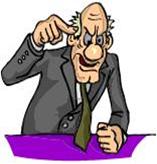What you do speaks so loudly that I cannot hear what you say.” Ralph Waldo Emerson
A couple of days ago I was at a function which brought together a variety of people from all walks of life. Looking around I noticed a couple of people talking together and I thought ‘They look like nice people’ so I went over and introduced myself; and found that they were, indeed, very nice people.
I bet that you have done the same on occasions, but have you ever wondered what led you to that conclusion – that they were, indeed, nice people? What then are the clues that lead us to believe, without a word spoken, or opinion exchanged, that this is someone I would like to know?
When we watch others we are relying on non-verbal cues; the visible actions which speak to our emotions, our heart, rather than our head. I am sure you would not be willing to cross the room to introduce yourself to someone leaning aggressively forward, finger pointing and speaking forcibly into the face of another. It would not just look wrong, it would feel wrong and that would impact on your willingness to engage in conversation – and yet not a word had been spoken between you.
Within any group there will be a variety of people with differing opinions, differing backgrounds, differing education, differing experiences and differing cultures [and that does not just mean inter-global cultural differences]. And sometimes we have to integrate them all into one team.
To do that we need to understand that communication is far more than just what we say. There is an unspoken language that we need to understand to be able to communicate in groups. It is the unspoken signal that should warn us of upcoming problems; the quizzical look that tells me I need to rephrase or restate my message; the frown, accompanied by a small shake of the head that gives me instant recognition that this person does not agree with my carefully prepared argument.
Such communication is a vital part of inter-personal relationships, and an essential tool in team building; so here are some facts about how non-verbal communication actually works.
• In any exchange of information, the non-verbal cues will outnumber the verbal ones. We are not normally aware of them, and while a lot will be reinforcing others will be rejecting. In a one-on-one situation, we can listen and watch at the same time to help us get a clearer understanding of the words and the meaning of the message.
However, when we are engaged in a group communication – as in teamwork for instance – then we are receiving a number of non-verbal cues from each member of that team in response to a verbal message, even if only one person is speaking.
• A non verbal response can often be instinctive and we may not be aware of it, but anyone watching us will see it. A fleeting expression may betray our confusion even while our words are denying it. Which leads onto the next important point…
• Non-verbal cues are believed. A physical response to information speaks to our emotions, and our feelings often direct the way that we think. For instance if I were to ask you if you liked my new dress and you said ‘of course I do’ with an involuntary small shake of the head, guess what – I would not believe you. I would see the negative movement and instinctively respond to that. Non-verbal cues are a representation of the speaker’s own emotion and if they are different to what is said the watcher will go with the emotion. Which also leads on to another important point…
• We don’t always recognise the real meaning, and we can misinterpret non-verbal messages as easily as we can spoken ones. This is probably one of the most misunderstood aspect of group communication. We have read books and articles that tell us that sitting back with arms crossed means the person is not open to your persuasion, they are ‘turned off’ to your message.
However, they could merely be cold, tired or just more comfortable with crossed arms. I am an inveterate ‘crossed arms’ listener, and I justify it by claiming I can listen better when I am not distracted. I am also an inveterate doodler!
To get the real meaning we need to look at the whole picture. Crossed arms? Tick! Looks angry? Tick! Strong eye contact? Tick! Then there is a strong possibility this person is not reacting positively to what you are saying.
Building a team means building relationships. Relationships are built on effective communication. To create a well functioning team we need to understand exactly what communication is designed to do, how we can utilise it effectively and – equally importantly – what barriers and interferences we may encounter during that communication.
Non-verbal language can be both a barrier and interference to clear communication; and because it speaks directly to our emotional awareness it impacts on the way we receive information, the way we process that information and the willingness we have to believe it and act on it.
“What you do speaks so loudly that I cannot hear what you say.” so make sure that what you do supports and reinforces what it is that you say. That is Team Building – Communication Style.
Michele @ Trischel.




